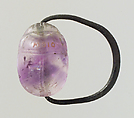Scarab Finger Ring
Middle Kingdom
The scarab (kheper) beetle was one of the most popular amulets in ancient Egypt because the insect was a symbol of the sun god Re. This association evolved from the Egyptians' misunderstanding of the scarab's life cycle. An adult beetle lays its eggs inside a ball of dung, which is then buried underground. When the young beetles hatch, the only portion of this process easily visible to an observer is the beetle emerging fully developed from a dung ball, a seemingly magical event. Thus, the Egyptian word for scarab translates as "to come into being."
The scarab forms food balls out of fresh dung using its back legs to push the oversized spheres along the ground toward its burrow. The Egyptians equated this process with the sun's daily cycle across the sky, believing that a giant scarab moved the sun from the eastern horizon to the west each day, making the amulet a potent symbol of rebirth. The earliest scarab amulets appeared in the First Intermediate Period (ca. 2124 B.C.). During the Middle and New Kingdoms, they often were used as seals as well as amulets (ca. 2030–1070 B.C.). Scarabs remained common amulets in the Late Period (ca. 712–332 B.C.), and were still in use in Greek and Roman times (332 B.C.–364 A.D.).
This image cannot be enlarged, viewed at full screen, or downloaded.
This artwork is meant to be viewed from right to left. Scroll left to view more.



